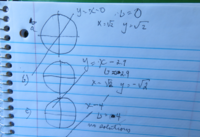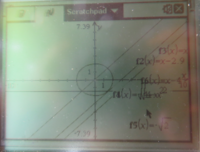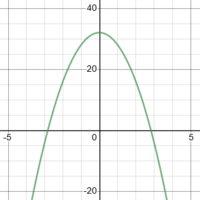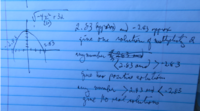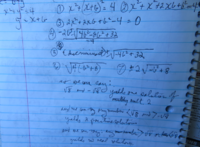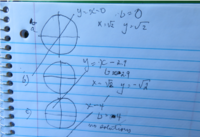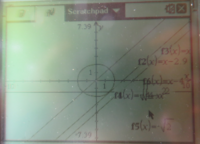To OP, I have absolutely no idea why you would choose to solve for y in x^2 + y^2 = 4 when it would involve sorts and +/- signs when you could have just substituted x+b for y as y=x+b was given!
I had enough of this post. Below are three ways to solve this problem.
1) x^2 + (x+b)^2 = 4
2x^2 + 2bx + b^2 = 4
2x^2 + 2bx + (b^2 - 4) = 0
x= [-2b +/- sqrt(4b^2 - 4*2*(b^2-4)]/4 = [-b +/- sqrt(b^2 - 2(b^2-4)]
Let's consider the discriminant. b^2 - *2*(b^2-4) = b^2 -2b^2+8 = -b^2 + 8
When is -b^2+8=0? When b =/- 2sqrt(2)
That is when you have one point of intersection. Think about how you will get two points of intersection and no points of intersection
Go and find the point which is easy to do.
2)x^2 + y^2 = 4 => y = +/-sqrt(4-x^2)
So +/-sqrt(4-x^2) = x+b
Then 4-x^2 = (x+b)^2 = x^2 + 2bx + b^2
Then 2x^2 + 2bx + (b^2-4) = 0. Now continue as above.
3)To have one point of the intersection the line y=x+b must be tangent to the x^2 + y^2 =4. The slope of y=x+b is 1 and the derivative of a circle is known to be y'= -x/y. Hence -x/y=1 or y=-x
Then x^2 + y^2 = 4 becomes x^2 + (-x)^2 = 4. Then x^2 = 2. So x=+/- sqrt(2)
This gives us the points (sqrt(2), - sqrt(2)) and (-sqrt(2), sqrt(2))
1st point: y = x + b so -sqrt(2) = sqrt(2) + b. So b = -2sqrt(2)
2nd point: sqrt(2) = -sqrt(2) + b. So b = sqrt(2).
if -sqrt(2) < b < sqrt(2) you have 2 points of intersection. If b = +/- sqrt(2) you have one point of intersection. Otherwise you have no points of intersection.
Comments: In my opinion the 3rd way is the way to do this problem. It is simple and shows a good understanding of what is going on.
If you have not YET reached the level of maturity to do this problem by method 3 you should then use method 1. I would never consider using method 2 HOWev

